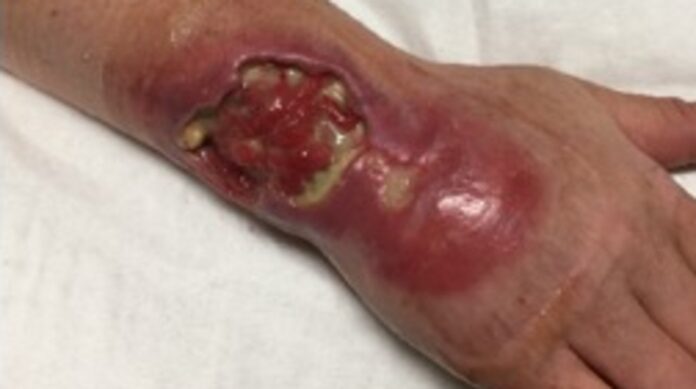[ad_1]
A record number of cases of flesh-eating ulcers was recorded in Victoria last year, prompting a warning from health authorities.
Some 363 cases of Buruli ulcers — which can create skin damage including open wounds, limb swelling and severe pain — were diagnosed in 2023.
Buruli ulcers were once rare in Australia but are now known to occur in several jurisdictions, including northern Queensland, the NT and Victoria.
The ulcers are caused by a bacteria, Mycobacterium ulcerans, that is transmitted via mosquitoes.
The first sign of infection is usually a small, painless lump that’s often dismissed as a bug bite.
But if left untreated, the slow-moving infection burrows into a layer of fat between the skin and the lining that covers muscles, where it begins to spread through the body before erupting through the skin in the form of an ulcer.
Deep Buruli ulcers can cause scarring of the muscles and tendons, which may result in permanent disability.
Small ulcers can be treated by antibiotics and usually heal within six months.
Most of last year’s cases were not severe but the Victorian Department of Health said early diagnosis was vital because the ulcers grow over time.
Anyone living in or visiting coastal areas was encouraged to take precautions against mosquitoes.
“Warmer weather provides mosquitoes with an ideal breeding environment,” Victoria’s acting health minister Ingrid Stitt said on Thursday.
“Victorians should use an insect repellent with DEET [diethyltoluamide], cover up when outdoors and practice good hygiene by washing new scratches and cuts.”
Ms Stitt also recommended people mosquito-proof their homes with fly screens, avoid mosquito-prone areas and stay indoors at dusk and dawn, when they’re most likely to be bitten.
The Buruli infection has spread in recent years to areas outside of where it’s typically found.
In 2022, 2121 new cases of Buruli ulcer were reported globally, mostly in sub-Saharan Africa and Australia, according to the World Health Organisation.
Victoria’s most high-risk areas include Rye, Sorrento, Blairgowrie and Tootgarook on the Mornington Peninsula.
Frankston and Seaford and towns on the Bellarine Peninsula including Ocean Grove, Point Lonsdale and Queenscliff are considered medium risk.
Since 2019, cases have also been reported in parts of Geelong and inner Melbourne, including Essendon, Moonee Ponds and Brunswick West.
[ad_2]
Source link


